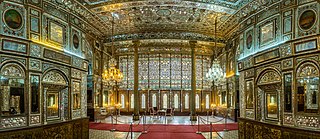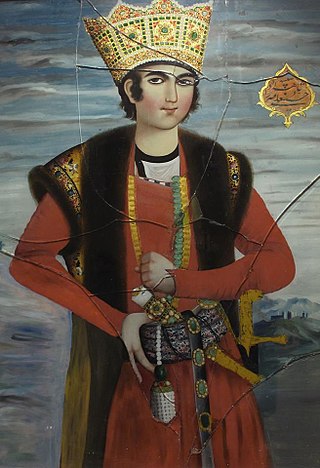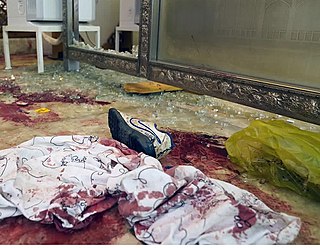Shah Cheragh attack may refer to:
Shah Cheragh attack may refer to:

An imamzadeh is a Persian term with two related meanings: a type of holy person in Shia Islam, and the shrine-tomb of such a person.

Shāh Chérāgh or Shahcheragh Shrine is the tomb of Ahmed bin Musa in the center of Shiraz. It is the third most important shrine in Shia Islam in Iran, after the Imam Reza shrine and Fatima Masumeh Shrine. Ahmed bin Musa traveled to Khorasan on the way to join his brother, but he was allegedly killed by Abbasid caliph al-Ma'mun, in Shiraz. Shāh-é-Chérāgh is a Persian term for "King of the Light". The site is the most important place of pilgrimage within the city of Shiraz.

Jameh Mosque of Atigh is a 9th-century mosque in Shiraz, the capital of Fars Province, Iran, Atigh Jameh mosque the oldest mosque of Shiraz was built in celebration of the conquest of Shiraz by Saffarid Amroleiss in the year 276 AH and was completed in 281 AH. It has been restored many times. The height of the building and its various nocturnal areas (Shabestans) with beautiful tile work on the ceilings, gives a unique charm to this place. It is located in the east of Shah Cheragh Shrine. The entrance door of Shah Cheragh is on the west side of the mosque. undefined Atiq Jame Mosque of Shiraz has been renovated several times. Nodbeh Wall and Khodaye Khane are some of the attractions of this mosque. Additionally, the dome of the north Iwan and the hypostyle columns are so attracting. In the southern part of this mosque, there is a wall called “Nodbeh”. It differentiates from other walls with a picture of colorful cedar on it. It is believed that on the night of Miraj, Boragh /Buraqpassed from this (Nodbeh) Wall. There is an Iwan and Shabestan. Shabestan is an underground space that can be usually found in the traditional architecture of mosques, houses, and schools in ancient Iran. These spaces were usually used during summers and could be ventilated by windcatchers and qanats. North side is also known as “Imam Gate”. North gate is decorated with Mogharnas tiles.
Aliabad Cheragh is a village in Khaveh-ye Jonubi Rural District, in the Central District of Delfan County, Lorestan Province, Iran. At the 2006 census, its population was 139, in 32 families.
Cheragh is a village in Khaveh-ye Jonubi Rural District, in the Central District of Delfan County, Lorestan Province, Iran. At the 2006 census, its population was 734, in 181 families.
Chah Cheragh is a village in Dowreh Rural District, Chegeni District, Dowreh County, Lorestan Province, Iran. At the 2006 census, its population was 150, in 31 families.
Cheshmeh-ye Cheragh Ali is a village in Robat Rural District, in the Central District of Khorramabad County, Lorestan Province, Iran. At the 2006 census, its population was 41, in 8 families.
Boneh-ye Cheragh is a village in Soltanabad Rural District, in the Central District of Ramhormoz County, Khuzestan Province, Iran. At the 2006 census, its population was 125, in 29 families.
Deh Cheragh is a village in Zalu Ab Rural District, in the Central District of Ravansar County, Kermanshah Province, Iran. At the 2006 census, its population was 148, in 33 families.
Cheragh Hesari is a village in Aq Bolagh Rural District, Sojas Rud District, Khodabandeh County, Zanjan Province, Iran. At the 2006 census, its population was 142, in 38 families.
Cheragh Mazraeh is a village in Aq Bolagh Rural District, Sojas Rud District, Khodabandeh County, Zanjan Province, Iran. At the 2006 census, its population was 109, in 23 families.
Bezni-ye Cheragh Mardan is a village in Charuymaq-e Shomalesharqi Rural District, in the Central District of Hashtrud County, East Azerbaijan Province, Iran. At the 2006 census, its population was 33, in 5 families.
Sari Beygluy-e Cheragh is a village in Nazlu-e Shomali Rural District, Nazlu District, Urmia County, West Azerbaijan Province, Iran. At the 2006 census, its population was 500, in 125 families.
Cheragh Veys is a village in Mir Deh Rural District, in the Central District of Saqqez County, Kurdistan Province, Iran. At the 2006 census, its population was 174, in 31 families. The village is populated by Kurds.
Shah Cheragh is a village in Marbin-e Vosta Rural District, in the Central District of Khomeyni Shahr County, Isfahan Province, Iran. At the 2006 census, its population was 30, in 10 families.
Cheragh Khan Zahedi, also known as Pirzadeh (پیرزاده), was an Iranian officer in Safavid Iran, who served as the head of the royal bodyguard (qurchi-bashi) from 1631 until his death in 1632.
Cheragh-Ali Khan Zanganeh was a prominent Iranian statesman during the early reign of the Qajar shah Naser al-Din Shah Qajar.

Āina-kāri is a kind of interior decoration where artists assemble finely cut mirrors together in geometric, calligraphic or foliage forms. This creates a beautiful shining surface covered with complex facets, reflecting light as intricate abstract patterns or glittering reflections. Beside their decorative use, this art an used as a strong durable cover for an interior space of a building. This type of mosaic work is commonly done in Iran, Pakistan and is also found is Mughal era buildings of India.

Hossein Ali Mirza, a son of Fath-Ali Shah, was the Governor of Fars and pretender to the throne of Qajar Iran.

The Shah Cheragh attack was a terrorist attack that occurred on 26 October 2022 at Shah Cheragh mosque, a Shia pilgrimage site in Shiraz in southern Iran, in which at least 13 people were killed.